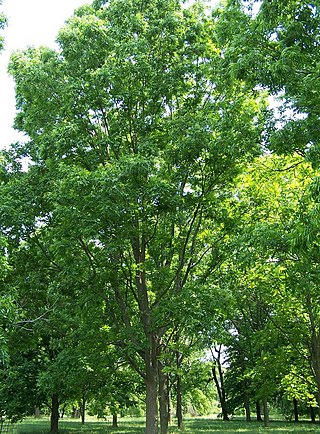
The pecan is a species of hickory native to the southern United States and northern Mexico in the region of the Mississippi River. The tree is cultivated for its seed primarily in the U.S. states of Georgia, New Mexico, and Texas, and in Mexico. The seed is an edible nut used as a snack and in various recipes, such as praline candy and pecan pie. The pecan is the state nut of Alabama, Arkansas, California, Texas and Louisiana, and is also the state tree of Texas.

The Juglandaceae are a plant family known as the walnut family. They are trees, or sometimes shrubs, in the order Fagales. Members of this family are native to the Americas, Eurasia, and Southeast Asia.

Hickory is a common name for trees composing the genus Carya, which includes around 18 species. Five or six species are native to China, Indochina, and India (Assam), as many as twelve are native to the United States, four are found in Mexico, and two to four are native to Canada. A number of hickory species are used for products like edible nuts or wood.

Carya ovata, the shagbark hickory, is a common hickory in the Eastern United States and southeast Canada. It is a large, deciduous tree, growing well over 100 ft (30 m) tall, and can live more than 350 years. The tallest measured shagbark, located in Savage Gulf, Tennessee, is over 150 ft (46 m) tall. Mature shagbarks are easy to recognize because, as their name implies, they have shaggy bark. This characteristic is, however, only found on mature trees; young specimens have smooth bark.

Malvin is a naturally occurring chemical of the anthocyanin family.

Rhododendron maximum — its common names include great laurel, great rhododendron, rosebay rhododendron, American rhododendron and big rhododendron — is a species of Rhododendron native to the Appalachians of eastern North America, from Alabama north to coastal Nova Scotia.

A protocarnivorous plant, according to some definitions, traps and kills insects or other animals but lacks the ability to either directly digest or absorb nutrients from its prey like a carnivorous plant. The morphological adaptations such as sticky trichomes or pitfall traps of protocarnivorous plants parallel the trap structures of confirmed carnivorous plants.

Plumbago auriculata, the cape leadwort, blue plumbago or Cape plumbago, is a species of flowering plant in the family Plumbaginaceae, native to South Africa.

The phenolic content in wine refers to the phenolic compounds—natural phenol and polyphenols—in wine, which include a large group of several hundred chemical compounds that affect the taste, color and mouthfeel of wine. These compounds include phenolic acids, stilbenoids, flavonols, dihydroflavonols, anthocyanins, flavanol monomers (catechins) and flavanol polymers (proanthocyanidins). This large group of natural phenols can be broadly separated into two categories, flavonoids and non-flavonoids. Flavonoids include the anthocyanins and tannins which contribute to the color and mouthfeel of the wine. The non-flavonoids include the stilbenoids such as resveratrol and phenolic acids such as benzoic, caffeic and cinnamic acids.

Trifolin is a chemical compound. It is the kaempferol 3-galactoside. It can be found in Camptotheca acuminata, in Euphorbia condylocarpa or in Consolida oliveriana.

Europinidin (Eu) is an O-methylated anthocyanidin. It is a water-soluble, bluish red plant dye. It is a rare O-methylated flavonoid, a derivative of delphinidin. It can be found in some species of Plumbago and Ceratostigma.

Azalein is a chemical compound. It is a flavonol, a type of flavonoid. It is the 3-O-α-L-rhamnoside of azaleatin. It can be found in the flowers of Plumbago and Rhododendron species.

Eupatolitin is a chemical compound. It is an O-methylated flavonol, a type of flavonoid. Eupatolitin can be found in Brickellia veronicaefolia and in Ipomopsis aggregata.

Herbacetin is a flavonol, a type of flavonoid.

Eupalitin is an O-methylated flavonol. It can be found in Ipomopsis aggregata.

Patuletin is an O-methylated flavonol. It can be found in the genus Eriocaulon.
Distichophytum is a genus of extinct vascular plants of the Late Silurian (Ludfordian) to Early Devonian (Emsian), around 426 to 393 million years ago. The genus has a tangled taxonomic history, also being known as Bucheria and Rebuchia.

Kaempferol 7-O-glucoside is a flavonol glucoside. It can be found in Smilax china, and in the fern Asplenium rhizophyllum, and its hybrid descendants, as part of a complex with caffeic acid.

Avicularin is a bio-active flavonol isolated from a number of plants including Polygonum aviculare, Rhododendron aureum and Taxillus kaempferi.

Persicarin is a sulfated flavonoid naturally found in the cells of several plant species, including the water dropwort. It was first isolated from water pepper in 1937 by Jeffrey Harborne. The name of persicarin is derived from the Latin name of the plant: Persicaria hydropiper. It is also found in dill and because it is then excreted into urine, that makes persicarin a potential biomarker for the consumption of this food. Persicarin has been reported to show some promising results in protecting against and treating type 1 diabetes-induced liver inflammation and damage in mice models.



















